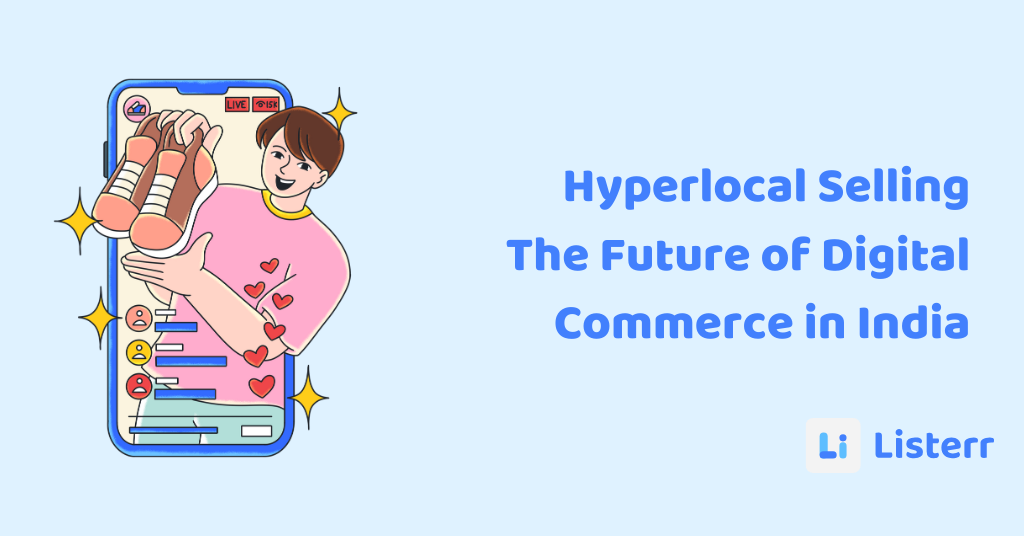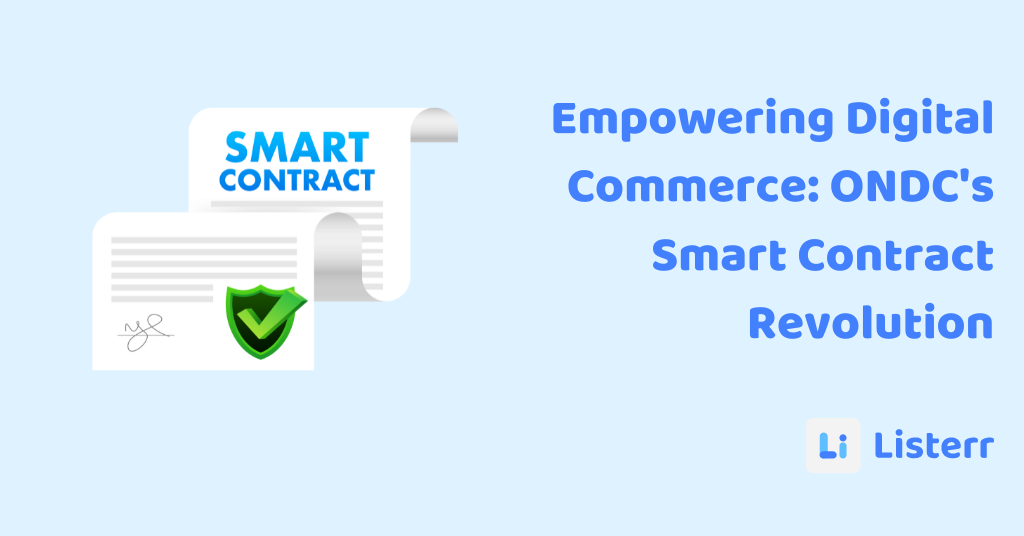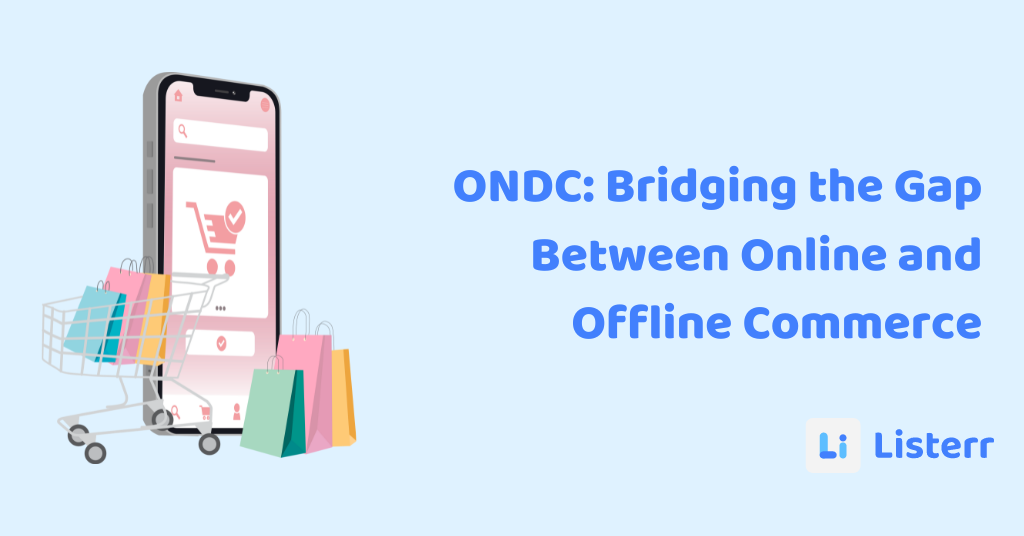Online sales is a rapidly growing element for many businesses, but few industries have taken advantage of eCommerce quite like the fashion industry.
Blooming online retailers like ASOS and Zalando are leading the charge for online trade, and demanding more and more from the industry.
But what advantages does this give to consumers and retailers? And just how much does the fashion industry need eCommerce? We have gathered key statistics about the current situation in the market and put together a comprehensive overview that will help you understand the best practices for apparel sellers and how to optimize your sales. This will include an analysis of the market, a study of successful apparel selling businesses, and an examination of the most effective methods for optimizing sales.
Fashion ecommerce general overview
Fashion retailers are increasingly finding success by selling their products online. In 2018, the global revenue for e-commerce fashion was $481 billion. This number increased to $545 billion in 2019 and is expected to continue growing, reaching $713 billion by 2022.
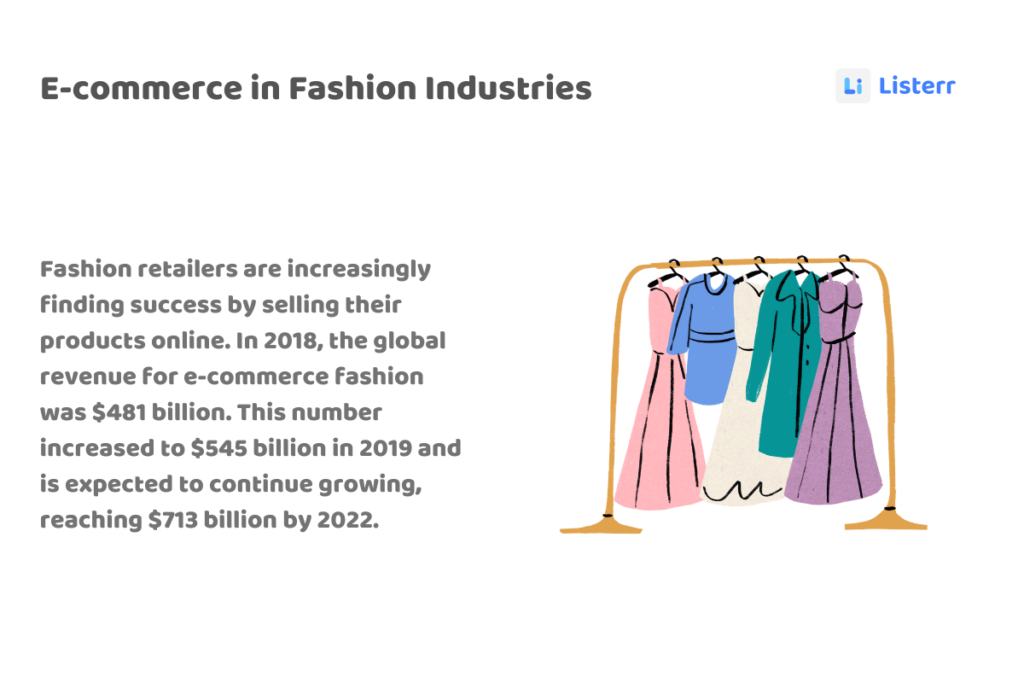
The popularity of online shopping has allowed businesses to generate more revenue and grow their operations. For the fashion industry, e-commerce has become an essential tool for success.
There’s no doubt that the fashion ecommerce industry has been on the rise in recent years and a lot of this can be attributed to the growing number of potential consumers. It’s estimated that there will be 1.2 billion new buyers by 2023, with the majority of them falling within the 16-35 age bracket.
When it comes to clothing, there are several sections that have seen growth and while some of these areas are slowing down, the projections are still positive.
One of the strongest sectors is accessories and bags which grew by an impressive 15.6% in 2018 and is still projected to grow by 8.7% by 2023.
There are a few other statistics that are worth mentioning when it comes to the growth of ecommerce in the fashion industry:
- 43% of purchases are made after personalised recommendations (via advertisements)
- 75% of consumers want brands to personalise messages, offers, and products
- China was the most free-spending nation in 2019, spending $740 billion on ecommerce. That is $179 billion more than what was spent in the USA (the second largest market).
- 77% of people in South Korea made an online fashion purchase in 2019. That is the highest of any nation.
Characteristics of the industry
Fashion ecommerce is showcased by a range of characteristics, which we will explore below.
Presentation – The design of any ecommerce website is crucial. Not only should it be easy to read and use, but it also needs to be visually appealing in order to stand out.
Service that excels – Many of the best online retailers use promotions and customer service together. By intertwining them, it binds customers to the brand and creates long lasting brand loyalty.
Loyalty schemes – Loyalty schemes are another way to build brand loyalty. Reward customers who return again and again. Loyalty schemes are showcased across almost any ecommerce-based business.
Alternative marketplaces – Whether this is via eBay, Facebook marketplace, Amazon, Bol or elsewhere, the biggest brands tend to offer other ways to buy their products.
Live chat – An easy way for customers with queries to get in touch.
Automation – The entire process can be done without conversation with another person. Just a few clicks and purchases are made.
What are fashion shoppers looking for?
Fashion shoppers are always on the lookout for new and innovative styles. They want to be able to find clothes that fit their personal style, and that they feel good in. comfort is also a key factor for fashion shoppers, as they don’t want to sacrifice style for comfort.
Personalization: online shoppers:
Customers appreciate being offered personalised deals and this often leads to them becoming more loyal to a store. If there is a discount or special offer that has been created specifically for them, they are much more likely to use that store instead of shopping around for the best deal. This is because personalised products make the customer feel valued and appreciated. They are also more likely to buy unique products that they cannot find anywhere else.
Reviews: building long lasting trust:
Over 98% of fashion buyers also stated the importance of reviews. This was down to customers wanting to get an honest perspective of the product they are considering buying. However, reviews were deemed less important when buying through trusted e-retailers with strong return policies.
Customized results: great filtering systems:
Finally, fashion shoppers also want to be able to quickly find the product they want. An easy and effective filter system can help make an online shop’s interface more user-friendly.
The best filtering systems allow customers to easily access other areas of an online fashion retailer (for example ‘striped shirts > blue striped shirts’). This allows customers to find similar products to the ones they searched for, as well as enjoy their browsing experience. Fashion shoppers may also use a variety of channels to filter for themselves.
Many online shoppers appreciate being able to find tailored results, and the Facebook Marketplace is a great example of this. It offers customized results and is increasing in popularity by 77% every month. This is just one of many relevant examples.
Best practices for apparel sellers
Social media presence
It’s no secret that social media platforms have the power to make or break a brand. With so many options to choose from, it can be difficult to decide which platform(s) to focus on for your business. If you’re in the fashion ecommerce industry, Instagram should be your go-to platform. On average, apparel brands receive 13.71 interactions (likes, comments, shares, etc.) per 1000 followers – which is significantly higher than the next best platform, LinkedIn, at 1.12 interactions per 1000 followers. Pinterest comes in at a close third with 0.49 interactions per 1000 followers. Instagram’s simplistic design draws attention to photos, making it the perfect platform to showcase your products and build a following of potential customers.
This allows fashion retailers to market their products on their primary functions, design and appearance.
The most common promotional practice on Instagram is the partnership with influencers. Sometimes influencers can be celebrities.
However, fashion brands tend to use lesser known influencers, with high amounts of followers. The aim of this is bridge the gap between the brand and potential customers and have someone easily relatable to promote the brands produce.
Most brands will utilize several other social media platforms alongside Instagram. They usually consist of Pinterest, Facebook, Twitter and Snapchat. If you’re interested in how you can increase revenue with Snapchat, check out this case study: Scaling Snapchat Revenue by 86% with 10x ROAS.
Each of these platforms has distinct advantages but in the case of the fashion industry, they are usually used alongside Instagram or one another to drive engagement.
Facebook’s advantage is that it allows online fashion stores to target specific demographics with advertisements. This means that the consumers seeing the adverts are more likely to be interested in what they are seeing.
Facebook is not only the most accurate social media for targeted demographics, it is also the most popular one, with 2.38 billion active users.
The sheer quantity of Facebook users means that brands can get more out of an advertisement on Facebook than anywhere else. However, on the downside, Facebook advertising might be intrusive at times and can be dismissed by users.
The number of Facebook users gives brands the potential to reach a large audience with their ads. However, some users may find Facebook ads to be intrusive and can easily dismiss them.
Twitter also uses demographic and geographic targeting for its advertising campaigns, similar to Facebook. However, one advantage of Twitter is that ads are integrated into the user’s timeline instead of being placed off to the side.
This means that whenever users scroll through their feed or trends, they will see advertising from fashion brands. This allows the brands to not only get an increased response to advertising, but also understand who isn’t interested in their advert. Additionally, it means brands can easily drive engagement with polls that most users will participate in, unlike on other platforms where they may be ignored.
Social media is a powerful tool that, when used correctly, can be extremely beneficial for apparel brands. It can help to drive engagement, gather data on consumers and build long lasting brand loyalty – all of which contribute to building and improve the brand both in the short and long term.
An often overlooked but important aspect of social media for apparel brands is the quality of data that retailers deliver to those platforms. When optimized, data feeds have a much higher chance of capturing the attention of buyers as the ads are better matched with the user’s interests, etc.
Website appearance
The way your website looks is very important for any online business – it’s often the first thing potential customers see and can form an opinion about your brand from. That being said, a website that is poorly designed can lead to lower sales and customers who do not return. So, for those reasons, online fashion stores put a lot of thought into their online appearance. Some of the most important areas to focus on for a successful ecommerce website are:
-Layout and design
-Aesthetics
-User experience
-Functionality
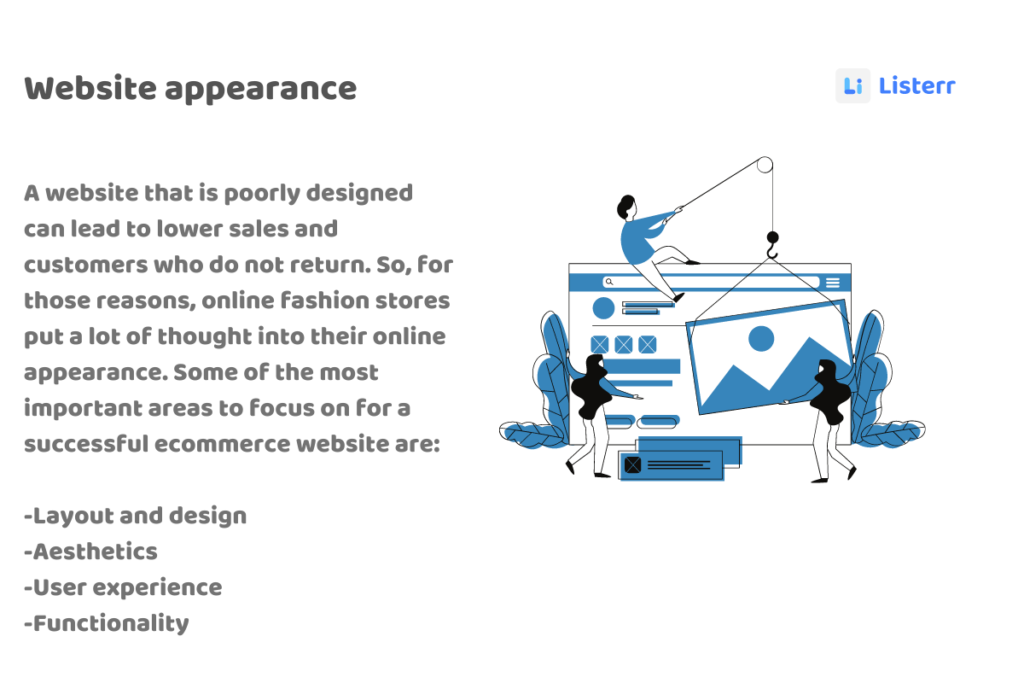
Best ways to communicate with customers
Ecommerce businesses have a few options available when it comes to communication with their customers. These include:
Live Chat – A fast and simple way to talk to customers via the website. Good for solving simple issues fast during working hours.
Email – Best for updating customers about orders and keeping them up to date with the latest promotion and fashion. Queries can also be answered but slower than Live Chat.
Phone – Good for solving issues fast and more personal than Live Chat.
Social Media – By becoming a part of buyers daily social life and gaining their trust you may win a relationship in the long run. This is fast and personal way of communicating with customers and resolving any issues. Thanks to familiarity built with social media presence you can announce promotions as well as new releases.
The most effective ways to boost sales
Of all the ways of increasing online sales in the fashion sector one of the most effective would be to be targeting existing loyal customers.
Offering regular personalised promotions will ensure customers keep coming back to the same brand for products. Common ways of achieving this are loyalty schemes, birthday discounts and even newsletters highlighting new features.
Besides working on boosting sales, another related way to increase loyalty among customers is by making their shopping experience more seamless and easier. This can be done in a number of ways, such as by being present on other platforms they might use or providing more payment options. Another idea could be to offer products that are related to current affairs or trends, as this will show that you’re keeping up with the times and that you understand your customer base. For example, ASOS saw an uptick in sales when they introduced a range of their own environmentally friendly products. By considering some or all of these methods, you’re sure to see an improvement in both customer loyalty and sales numbers.
Expanding your reach to sell across more channels and going global are the most common ways to increase sales of your existing products. Try to expand your market reach and go multichannel.
Expanding to different geographies and cultural groups will expose your products to new audience.
Optimizing and improving sale
Channels to sell online
If you are looking to sell fashion and apparel online on a large scale, you will need to utilise a variety of different channels. The best channels to sell fashion items on currently are:
Google shopping – Google is usually the primary place people search and therefore a great choice. Check out how to improve customer conversion with Google Shopping.
Facebook Marketplace – Facebook tailors products shown to what users like or show interest in. Therefore you are more likely to hit your target demographic.
Instagram – a good option for online fashion stores due to its targeting and focus on product images.
Listerr- Listerr is an online marketplace that is perfect for selling your dress without having to worry about any commission fees. With Listerr, you can be confident that you will be able to find a buyer for your dress quickly and without any hassle. Learn more about how to sell on Listerr .
The importance of feed quality
Data feeds are vital when selling apparel on multiple channels. Therefore it is important to have a high-quality data feed. A good feed is essential as it gives you an advantage over the competition.
Advantages of a good quality feed include:
All product information is consistent and stored in one place. This makes it easier to use the information and helps to ensure information on every marketplace is up to date
An effective feed will lead more people into seeing your product and increase general visibility over all the channels.
Feeds are a simple and easy way to manage all the information
New customers can be acquired, as well as current customers maintained with the data collected.
If optimized correctly, a data feed can vastly improve sales. Accurate product descriptions with appropriate and well-placed keywords can lead to a product being shown higher and more frequently in marketplaces.
Summary
eCommerce is developing rapidly, and it’s more important than ever to keep up-to-date with the latest information. Data is the best way to understand what customers want, but it’s also important to use data to keep loyal customers. As eCommerce continues to grow, competition will increase between retailers. The ones that survive will be the ones who manage information effectively.
ecommerceFashion and Apparel Industry